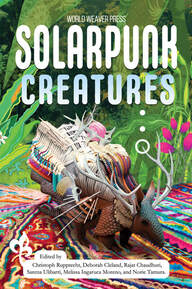 Guest Blog by Andrew Knighton Writing a story always involves iteration, trying different versions of characters, plots, and wording. Usually, that stuff stays hidden, old versions disappearing into the darkness of the writer’s drafts folder. My Solarpunk Creatures story, The Business of Bees, was the second complete variation on a story with the same core idea but completely different execution. I was fond enough of that previous story, A Conspiracy of Pigeons, to share it on my blog, but not enough to submit it to the anthology. So in the name of letting other people learn from my mistakes, let’s look at the similarities and differences between these stories, and why I didn’t stop at the first one. What’s the Same?The first similarity is the protagonist. Both of these stories are told from the point of view of a cat, named Leo in Conspiracy and Luna in Business. Both cats are curious and adventurous. The structure of the two stories is pretty much the same. Our hero sees creatures in their city doing something strange, follows them to find out why, and discovers something unexpected that challenges our models of how nature fits into human society. There’s some similarity of setting. Both stories take place in a future where humanity has dealt with the self-imposed problems of climate change. But the specifics of those cities are where things start to diverge… What’s Different?Leo’s city is one abandoned by humanity, left to rot as an example of past mistakes. The humans live in shining cities visible on the horizon, but that’s not where the story takes place. Leo’s landscape is a ruined one. Luna, on the other hand, lives in one of those shining cities. The landscape she explores is an illustration of how we might build better, with renewable energy and rooftop gardens. Hope is all around rather than over the horizon. This change is mirrored in the creatures the cats are following. Leo is pursuing pigeons, which are, rightly or wrongly, widely seen as unclean pests. Luna, on the other hand, follows bees, symbols of industry and cooperation, insects we increasingly idealise as we recognise their importance to our environment. The result is a story that, while similar in its structure and message, has a very different tone. Why the Change?So why write the second version? And if that was what I submitted to the anthology, why publish the first one? I wrote A Conspiracy of Pigeons to fit the Solarpunk Creatures call for stories – something animal centred set in a solarpunk future. But while I was happy with the story, and it technically filled the brief, I could tell straight away that it wasn’t right. Sure, the humans of that setting live in a solarpunk future, but Leo doesn’t. His exclusion from it sets a dark tone, when people read solarpunk for brightness and hope. So I took what I had and thought about how I could keep the suitable bits while ditching the rest. That led to The Business of Bees, which fits the anthology brief in a meaningful way, not just a technical one. It’s designed to match readers’ expectations, which will mean a more satisfying read. Still, I liked Conspiracy. I liked Leo. I thought his story was worth reading, and different enough from Luna’s for both to exist in the world. So now there are two stories, and a lesson for me, maybe even for you. When you’re writing a story, think about tone and emotion, about how you’ll match the needs both of editors and of readers. Just because a story is good doesn’t mean it’s the right one for the moment, and just because it’s not right now doesn’t mean it needs to go to waste. Andrew Knighton has been writing for longer than he likes to admit, creating short stories, comics, and the fantasy novellas Ashes of the Ancestors and Silver and Gold. He lives in Yorkshire with an academic, a cat, and many unread books. Find him at andrewknighton.com and on Mastodon as @[email protected].
0 Comments
Your comment will be posted after it is approved.
Leave a Reply. |
World Weaver PressPublishing fantasy, paranormal, and science fiction. Archives
February 2024
|
- Home
-
Books
-
All Books
>
- Beyond the Glass Slipper
- Bite Somebody
- Bite Somebody Else
- Black Pearl Dreaming
- Cassandra Complex
- Causality Loop
- Clockwork, Curses, and Coal
- Continuum
- Corvidae
- Cursed: Wickedly Fun Stories
- Dream Eater
- Equus
- Fae
- Falling of the Moon
- Far Orbit
- Far Orbit Apogee
- Fractured Days
- Frozen Fairy Tales
- Glass and Gardens: Solarpunk Summers
- Glass and Gardens: Solarpunk Winters
- Grandmother Paradox
- Grimm, Grit, and Gasoline
- Haunted Housewives
- Heir to the Lamp
- He Sees You When He's Creepin': Tales of Krampus
- Into the Moonless Night
- Jack Jetstark's Intergalactic Freakshow
- King of Ash and Bones (ebook)
- Krampusnacht
- Last Dream of Her Mortal Soul
- Meddlers of Moonshine
- Mothers of Enchantment
- Mrs Claus
- Multispecies Cities
- Murder in the Generative Kitchen
- Recognize Fascism
- Scarecrow
- Sirens
- Shards of History
- Shattered Fates
- Skull and Pestle
- Solarpunk (Translation)
- Solarpunk Creatures
- Solomon's Bell
- SonofaWitch!
- Speculative Story Bites
- Trenchcoats, Towers, and Trolls
- Weredog Whisperer
- Wolves and Witches
- Anthologies and Collections
- Novels
- Novellas
- Fairy Tale
- Fantasy
- Romance
- Science Fiction
- Urban/Contemporary Fantasy
- Young Adult SFF
-
All Books
>
- Blog
- About
- Contact
- Press / Publicity
- Newsletter Signup
- Privacy Policy
- Store

 RSS Feed
RSS Feed